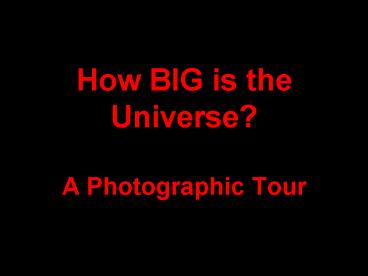How BIG is the Universe A Photographic Tour - PowerPoint PPT Presentation
1 / 60
Title:
How BIG is the Universe A Photographic Tour
Description:
The constellation of Orion. and the Milky Way (The bright stars we see here ... forming in Orion ... How Orion would look if you were near a black hole ... – PowerPoint PPT presentation
Number of Views:694
Avg rating:3.0/5.0
Title: How BIG is the Universe A Photographic Tour
1
How BIG is the Universe?A Photographic Tour
2
Apollo 17 Lunar Rover(scale a few metres)
3
Space Shuttle, Columbia(scale 100 metres)
4
Barringer Crater, Arizona(1.2 km diam, 200 m
deep - 50 m diam asteroid at 11 km/s)
5
Earth(diam 12,756 km)
6
Cloud covered Venus(0.95 Earth diameters)
7
Mercury(0.38 Earth diameters)
8
The Moon(0.27 Earth diameters)
9
The Sun(diam 1 392 000 km or 109 Earth
diameters,distance 150 000 000 km or 1
astronomical unit - 1 AU)
10
Eclipse of the Sun by the Moon as seen from
Antarctica(both subtend almost exactly the same
angle of half a degree at the Earth)
11
Mars - the Red Planet(0.53 Earth diam)
12
Surface of Mars
13
Phobos and Deimos(max lengths 28 and 16 km)
14
Orbits of the planets to scale
15
Asteroid Gaspra(20 km long)
16
Jupiter and its Great Red Spot (11.2 Earth
diam,distance 5.2 AU)
17
Jupiters cloud belts as seen by the Cassini
spacecraft
18
Jupiter with (top to bottom)Io, Europa, Ganymede
and Callisto
19
Io and its sulphur volcanoes(0.28 Earth diam,
1.04 Moon diam)
20
Ganymede, largest moonin the Solar System
(0.41 Earth diam,1.51 Moon diam)
21
Not all Jupiters moons are largeThebe (100
km), Amalthea (270 km max) and Metis (40 km)
22
Saturn and its beautiful rings(9.4 Earth diam at
9.6 AU)
23
Orbits of the planets to scale
24
Uranus, the tilted planet(4.0 Earth diamat 19.2
AU)
25
Neptune(3.9 Earth diamat 30.1 AU)
26
Pluto and Charon - double planet(0.18 and 0.09
Earth diam1.54 Earth diam apartat 29.7 to 49.4
AU from Sun)
27
Comet Hale-Bopp in March 1997A comet tail can
be over 1 AU long,but its nucleus measures only
a few km across
28
Comet Halley and the Milky Way
29
Southern Pinwheel Galaxy 15 million light years
away and similar to the Milky Way
30
How the Milky Way might look seen edge-on
Sun
160 million light years
31
Size of the Milky Way Galaxy
32
Sombrero Galaxy
33
Whirlpool Galaxy
34
Andromeda Galaxy(2.5 million light years away
-most distant naked eye object)
35
Giant Elliptical Galaxy M87in Virgo Cluster50
million light years away
36
Virgo Cluster of Galaxies1500 galaxies9 million
light years across50 million light years away
37
ComaCluster
38
Hubble Deep Field showing galaxies over 10
billion light years away (looking back in time to
near the beginning of the universe)
39
How the Milky Way might look seen edge-on
Sun
160 million light years
40
The Milky Way as seen from Australia(Notice the
pink nebulae where new stars are forming)
41
Milky Way with Faulkes Telescope in Australia in
foreground
42
The constellation of Orionand the Milky Way(The
bright stars we see here are no more than a few
hundred light years away)
Betelgeuse
Rigel
OrionNebula
43
Orion Nebulaa small star forming region about 1
light year across
44
New solar systems forming in Orion
45
New stars forming in pillars of molecular
hydrogen and dust that are light years in length
(in Eagle Nebula)
46
Pleiades and Hyadesstar clusters(with Jupiter
and Saturn)
47
Betelgeuse - a Red Supergiant star(big enough to
reach the orbit of Jupiter)
48
Life Cyclesof Stars in Outline
49
Helix Planetary Nebula (1.5 light years across)
White dwarf star(remains of core of star and
about size of the Earth)
Planetary nebula(remains of outer layers of
star)
50
Cats Eye Planetary Nebula and white dwarf(A
solar mass white dwarf would be only as big as
the Earth)
51
Cocoon Planetary Nebula
52
Ring Planetary Nebula
53
Abell Planetary Nebula
54
Crab Nebula a supernova remnant - remains of a
star that exploded10 light years across
neutron star about 10 kmacross is at centre (not
visible)
55
Vela or GumNebula
56
A Black Hole(Radius of a 10 solar mass black
hole would be only 30 km)
57
A black hole a few million times the mass of the
Sun lurks at the centre of our galaxy and causes
nearby stars to orbit very rapidly
58
How Orion would look if you were near a black
hole (computer simulation)
59
Gravitational lensing by a galaxy cluster 2
billion light years away bends light from a
galaxy so far away that its light has been
travelling for 95 of the age of the Universe
60
The End































